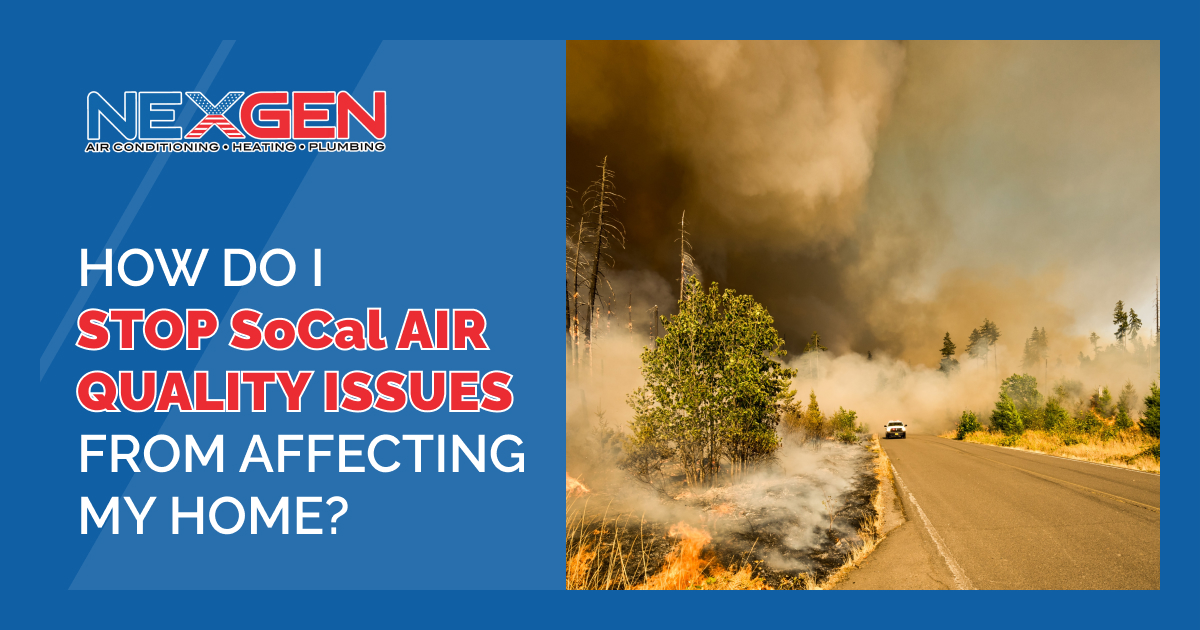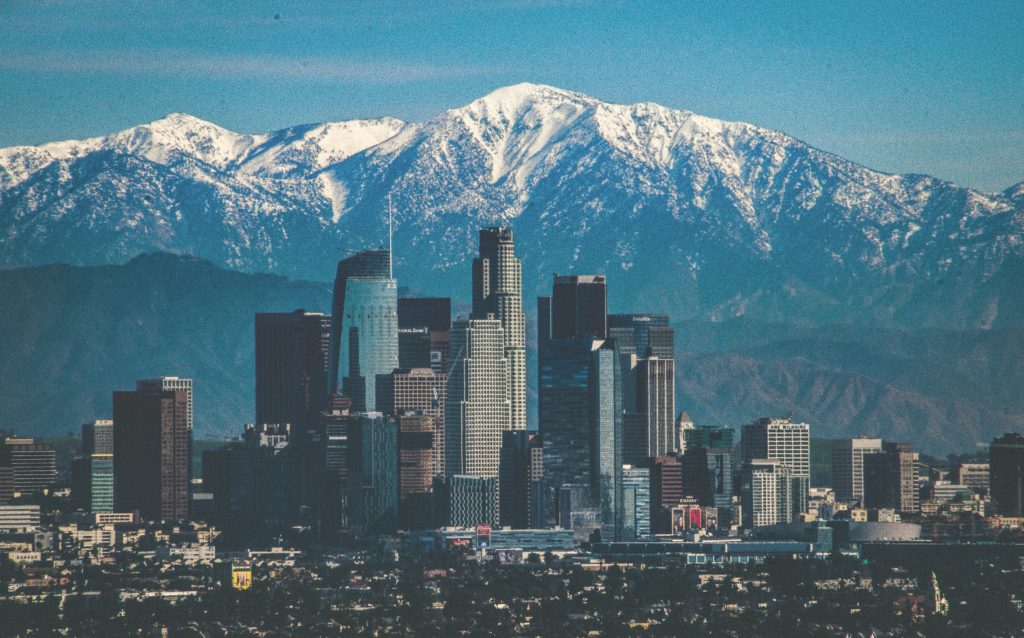How to Stop SoCal Air Quality from Affecting Your Home
 Southern California is renowned for its poor air quality. There are many sources of air pollution here, including motor vehicles, industry, seaports, dust, and smoke from wildfires that can drift hundreds of miles. Even if you’re not near a fire zone, busy road, or industrial area, your home can be affected by chemicals and small particles. But you don’t have to let SoCal air quality put your family at risk.
Southern California is renowned for its poor air quality. There are many sources of air pollution here, including motor vehicles, industry, seaports, dust, and smoke from wildfires that can drift hundreds of miles. Even if you’re not near a fire zone, busy road, or industrial area, your home can be affected by chemicals and small particles. But you don’t have to let SoCal air quality put your family at risk.
Why You Must Protect Yourself from Wildfire Smoke
Wildfire smoke appears dense and dark from a distance. It may seem you’re in the clear, but you can breathe it in and not realize it; many of the particles and chemicals aren’t visible to the naked eye. These can cause immediate symptoms such as coughing and difficulty breathing, irritated eyes, headaches, scratchy throat, dizziness, and chest pain.
Children, the elderly, and people with heart and lung conditions are most vulnerable. But smoke is bad for everyone. Exposure stresses the cardiovascular system, so severe exposure can lead to stroke and heart attack. Your home doesn’t have to be in the path of a wildfire for you and your family to be affected.
Protecting Your Home Against Poor SoCal Air Quality
You can reduce the risk of air quality issues polluting your home by:
Installing High-Efficiency Air Filters
Not all HVAC filters remove the particles found in SoCal air. It’s important to check, clean, and change filters often, but consider installing high-efficiency particulate air (HEPA) filters for increased protection. Particulate matter can be smaller than 2.5 microns in diameter and can reach the deepest parts of the lungs. By comparison, a single human hair is 50 to 70 microns in diameter. A HEPA filter will trap the tiniest particles as air circulates through your heating and cooling system.
Similarly, N95 respirator masks can protect against particulates, smoke, and COVID-19. Wear a mask if you must be outside in smoky or smoggy conditions. It should fit over the nose and under the chin; one strap goes above and one strap goes below the ears. Air should not pull in from the sides when you breathe in (if properly fit, the respirator will collapse as you do).
Keeping the Windows Closed
Closing all your windows is generally effective in keeping out air pollution. However, most homes aren’t perfectly sealed envelopes. So in addition to closing windows, use high-quality filters and fans that boost air circulation in your home.
Setting Your AC to “Recirculate”
If your air conditioning system recirculates and filters the air, instead of drawing it in from outside, you can reduce the chances of outdoor pollutants getting in. Close any vents that deliver outdoor air. Turn off the fresh air intake as well. Of course, this only works if the filter is clean, so be sure to replace your HVAC filter often and when it is dirty.
Using an Air Purifier
Purchase an air purifier that’s been tested for removing small particles. It should be non-ozone generating and approved by the California Air Resources Board (CARB). Mechanical air cleaners don’t generate ozone or ions and physically filter out the air using pleated or HEPA-style filters. While electronic filters may generate small concentrations of ozone, they can include technologies such as UV light, ionizers, or electrostatic precipitators.
How to Protect Yourself from Poor Air Quality
In addition to keeping dirty air out of your home, you can protect yourself from SoCal air quality issues with the following tips:
- Do not run a swamp cooler or whole house fan.
- Avoid vacuuming or dusting when air quality is poor.
- Use HEPA-filtered vacuums and wet mops.
- Refrain from using gas stoves or burning candles.
- Keep your central air “On” rather than using the “Auto” setting.
- Stay indoors and avoid overexerting yourself.
Contact NexGen for Indoor Air Quality Solutions
We offer a range of indoor air quality solutions for Southern California homes and businesses. These protect against particulates, volatile compounds, smoke, and more. When SoCal air quality turns for the worst, you can depend on NexGen to install the highest quality air filters, air cleaners, and air purification systems. We also provide high-quality duct cleaning, air duct sealing, and insulation services. Call 833-729-9735 to learn more.
Southern California has the worst air pollution in the USA

If you've ever seen a brown haze of pollution hanging over your city, your most likely response may be, "Ugh. How can I avoid breathing that stuff?" But let's face it, even if you know it's a bad air day, you probably need to grab some sunshine, get in an outdoor run, or get to work.
Polluted air contains particulate matter, lead, ozone, nitrogen dioxide, carbon monoxide, and sulfur dioxide -- all of which can cause problems in people with allergies or asthma. Even if pollution is low, airborne pollen and mold can make a trip outdoors particularly daunting for people with respiratory conditions.
How to tell if it's a bad air day
The first step toward protecting your lungs is to know your city or town. More than 115 million people nationwide still live in counties with pollution levels considered potentially harmful to their health.
Air quality varies widely around the United States. Ozone, for instance -- which can pose a major problem for asthmatics -- tends to be more prevalent in urban areas like Los Angeles, though it can be found in suburban and rural areas as well. If you live in Fargo, North Dakota -- one of the cities with the cleanest air in the nation -- you are likely to breathe easier than if you live in Los Angeles, which has the highest ozone levels in the country.
Local weather stations often provide this information on their websites, and radio stations typically give ozone alerts. In addition, many websites can tell you if pollutants, ozone, or pollen counts are high in your area on any given day.
- AirNow.gov, a site run by federal government agencies, provides a daily Air Quality Index as well as other useful information on air quality.
- The American Academy of Allergy, Asthma & Immunology National Allergy Bureau has a daily mold and pollen report.
- The American Lung Association rates the air quality annually by state at stateoftheair.org.
- The Environmental Protection Agency has a feature on its website called My Environment, which gives you an up-to-date air-quality forecast for your zip code.
- Pollen.com offers a four-day allergy forecast using data from the National Weather Service.
However, it's not just pollen or air pollution that can trigger problems. Dr. Michael Benninger, M.D., the chairman of the Head and Neck Institute at the Cleveland Clinic, in Ohio, says changes in barometric pressure and temperature can also spell trouble for people with allergies to pollen and mold, people with severe sinus symptoms, and even people without allergies.
How to cope with bad air days
Once you've figured out what factors are most likely to pose a problem (usually by trial and error, or testing for allergies), and know the conditions in your area, there are several things you can do to cope.
One option is to reduce excessive exposure on days that might trigger symptoms. For example, Benninger recommends avoiding areas where pollen, mold, or other allergens are high. If you know that grass and trees are a problem, don't spend the day in a lush, tree-filled park; if you have to mow your lawn, wear a mask with a filter to reduce exposure to grass. Staying indoors with the windows closed and the air-conditioning on is also helpful, Benninger says.
Call NexGen Today
Our expertise and commitment to customer satisfaction make us the leading HVAC company in Southern California. To learn more about our equipment, services, and protection plan,
book an appointment online or call
888-277-0415.










